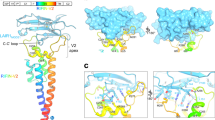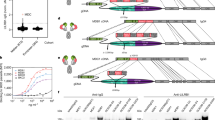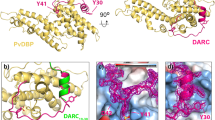Abstract
The Plasmodium species that cause malaria are obligate intracellular parasites, and disease symptoms occur when these parasites replicate in human blood. Despite the risk of immune detection, the parasite delivers proteins that bind to host receptors on the cell surfaces of infected erythrocytes. In the causative parasite of the most deadly form of malaria in humans, Plasmodium falciparum, RIFINs form the largest family of surface proteins displayed by erythrocytes1. Some RIFINs can bind to inhibitory immune receptors, and these RIFINs act as targets for unusual antibodies that contain a LAIR1 ectodomain2,3,4 or as ligands for LILRB15. RIFINs stimulate the activation of and signalling by LILRB15, which could potentially lead to the dampening of human immune responses. Here, to understand how RIFINs activate LILRB1-mediated signalling, we determine the structure of a RIFIN bound to LILRB1. We show that this RIFIN mimics the natural activating ligand of LILRB1, MHC class I, in its LILRB1-binding mode. A single mutation in the RIFIN disrupts the complex, blocks LILRB1 binding of all tested RIFINs and abolishes signalling in a reporter assay. In a supported lipid bilayer system, which mimics the activation of natural killer (NK) cells by antibody-dependent cell-mediated cytotoxicity, both RIFIN and MHC are recruited to the immunological synapse of NK cells and reduce the activation of NK cells, as measured by the mobilization of perforin. Therefore, LILRB1-binding RIFINs mimic the binding mode of the natural ligand of LILRB1 and suppress the function of NK cells.
This is a preview of subscription content, access via your institution
Access options
Access Nature and 54 other Nature Portfolio journals
Get Nature+, our best-value online-access subscription
$29.99 / 30 days
cancel any time
Subscribe to this journal
Receive 51 print issues and online access
$199.00 per year
only $3.90 per issue
Buy this article
- Purchase on Springer Link
- Instant access to full article PDF
Prices may be subject to local taxes which are calculated during checkout



Similar content being viewed by others
Data availability
Coordinates and structure factors are available from the Protein Data Bank under accession code 6ZDX. Flow cytometry data are deposited at FigShare (https://doi.org/10.6084/m9.figshare.c.5025038.v1). Source data are provided with this paper.
References
Chan, J. A., Fowkes, F. J. & Beeson, J. G. Surface antigens of Plasmodium falciparum-infected erythrocytes as immune targets and malaria vaccine candidates. Cell. Mol. Life Sci. 71, 3633–3657 (2014).
Tan, J. et al. A LAIR1 insertion generates broadly reactive antibodies against malaria variant antigens. Nature 529, 105–109 (2016).
Pieper, K. et al. Public antibodies to malaria antigens generated by two LAIR1 insertion modalities. Nature 548, 597–601 (2017).
Hsieh, F. L. & Higgins, M. K. The structure of a LAIR1-containing human antibody reveals a novel mechanism of antigen recognition. eLife 6, e27311 (2017).
Saito, F. et al. Immune evasion of Plasmodium falciparum by RIFIN via inhibitory receptors. Nature 552, 101–105 (2017).
Bachmann, A. et al. A comparative study of the localization and membrane topology of members of the RIFIN, STEVOR and PfMC-2TM protein families in Plasmodium falciparum-infected erythrocytes. Malar. J. 14, 274 (2015).
Goel, S. et al. RIFINs are adhesins implicated in severe Plasmodium falciparum malaria. Nat. Med. 21, 314–317 (2015).
Wang, Q. et al. Structures of the four Ig-like domain LILRB2 and the four-domain LILRB1 and HLA-G1 complex. Cell. Mol. Immunol. https://doi.org/10.1038/s41423-019-0258-5 (2019).
Nam, G. et al. Crystal structures of the two membrane-proximal Ig-like domains (D3D4) of LILRB1/B2: alternative models for their involvement in peptide-HLA binding. Protein Cell 4, 761–770 (2013).
Willcox, B. E., Thomas, L. M. & Bjorkman, P. J. Crystal structure of HLA-A2 bound to LIR-1, a host and viral major histocompatibility complex receptor. Nat. Immunol. 4, 913–919 (2003).
Higgins, M. K. & Carrington, M. Sequence variation and structural conservation allows development of novel function and immune evasion in parasite surface protein families. Protein Sci. 23, 354–365 (2014).
Chapman, T. L., Heikema, A. P., West, A. P. Jr & Bjorkman, P. J. Crystal structure and ligand binding properties of the D1D2 region of the inhibitory receptor LIR-1 (ILT2). Immunity 13, 727–736 (2000).
Hsieh, F. L. et al. The structural basis for CD36 binding by the malaria parasite. Nat. Commun. 7, 12837 (2016).
Lau, C. K. et al. Structural conservation despite huge sequence diversity allows EPCR binding by the PfEMP1 family implicated in severe childhood malaria. Cell Host Microbe 17, 118–129 (2015).
Lennartz, F., Smith, C., Craig, A. G. & Higgins, M. K. Structural insights into diverse modes of ICAM-1 binding by Plasmodium falciparum-infected erythrocytes. Proc. Natl Acad. Sci. USA 116, 20124–20134 (2019).
Colonna, M. et al. A common inhibitory receptor for major histocompatibility complex class I molecules on human lymphoid and myelomonocytic cells. J. Exp. Med. 186, 1809–1818 (1997).
Grakoui, A. et al. The immunological synapse: a molecular machine controlling T cell activation. Science 285, 221–227 (1999).
Dustin, M. L. & Baldari, C. T. The immune synapse: past, present, and future. Methods Mol. Biol. 1584, 1–5 (2017).
Arora, G. et al. NK cells inhibit Plasmodium falciparum growth in red blood cells via antibody-dependent cellular cytotoxicity. eLife 7, e36806 (2018).
Burrack, K. S., Hart, G. T. & Hamilton, S. E. Contributions of natural killer cells to the immune response against Plasmodium. Malar. J. 18, 321 (2019).
Winter, G. et al. DIALS: implementation and evaluation of a new integration package. Acta Crystallogr. D 74, 85–97 (2018).
Winn, M. D. et al. Overview of the CCP4 suite and current developments. Acta Crystallogr. D 67, 235–242 (2011).
McCoy, A. J. et al. Phaser crystallographic software. J. Appl. Crystallogr. 40, 658–674 (2007).
Emsley, P., Lohkamp, B., Scott, W. G. & Cowtan, K. Features and development of Coot. Acta Crystallogr. D 66, 486–501 (2010).
Bricogne, G. et al. BUSTER v.2.10.3 (Global Phasing, 2019).
Böhme, U., Otto, T. D., Sanders, M., Newbold, C. I. & Berriman, M. Progression of the canonical reference malaria parasite genome from 2002–2019. Wellcome Open Res. 4, 58 (2019).
Edgar, R. C. MUSCLE: multiple sequence alignment with high accuracy and high throughput. Nucleic Acids Res. 32, 1792–1797 (2004).
Crooks, G. E., Hon, G., Chandonia, J. M. & Brenner, S. E. WebLogo: a sequence logo generator. Genome Res. 14, 1188–1190 (2004).
Shiroishi, M. et al. Efficient leukocyte Ig-like receptor signaling and crystal structure of disulfide-linked HLA-G dimer. J. Biol. Chem. 281, 10439–10447 (2006).
Iwanaga, S., Kato, T., Kaneko, I. & Yuda, M. Centromere plasmid: a new genetic tool for the study of Plasmodium falciparum. PLoS ONE 7, e33326 (2012).
Hirayasu, K. et al. Microbially cleaved immunoglobulins are sensed by the innate immune receptor LILRA2. Nat. Microbiol. 1, 16054 (2016).
Choudhuri, K. et al. Polarized release of T-cell-receptor-enriched microvesicles at the immunological synapse. Nature 507, 118–123 (2014).
Alanine, D.G.W. et al. Human antibodies that slow erythrocyte invasion potentiate malaria-neutralizing antibodies. Cell 178, 216–228 (2019).
Acknowledgements
M.K.H. is funded by a Wellcome Investigator Award (101020/Z/13/Z). T.E.H. is funded by the Peter J. Braam graduate scholarship for Global Wellbeing at Merton College, Oxford. A.M.M. is funded by the Wellcome Trust PhD Studentship in Science (108869/Z/15/Z). J.H.F. is a Wellcome Trust Sir Henry Wellcome Fellow (107375/Z/15/Z). M.L.D. is a Wellcome Trust Principal Research Fellow (100262Z/12/Z). H.A. is funded by JSPS KAKENHI (JP 18H05279 and 19H04808) and AMED J-PRIDE (19fm0208004h0003). A.S. is supported by a JSPS Research Fellowship for Young Scientists (18J20300). A.J.R. is funded by the Wellcome Trust (206194/Z/17/Z) and the Medical Research Council (programme grant MR/M003906/1). We thank E. Lowe and the staff at beamline Promixa1 at Soleil for help with crystallographic data collection, D. Staunton for help with biophysical analysis, S. Davis and E. Jenkins for supplying recombinant pMHC-His, T. Hori for P. falciparum culture and S. Iwanaga for generation of RIFIN-transgenic P. falciparum.
Author information
Authors and Affiliations
Contributions
T.E.H. produced proteins and conducted biophysical analyses. T.E.H. and M.K.H. determined the crystal structure. A.M.M., J.H.F. and M.L.D. designed, conducted and analysed SLB imaging experiments. A.S. and H.A. designed, conducted and analysed reporter assay studies and flow cytometry studies of RIFIN mutants. T.E.H. and A.J.R. performed bioinformatics experiments. T.E.H. and M.K.H. devised the study and drafted the manuscript. All authors discussed the results, contributed to figures and text and commented on the manuscript.
Corresponding author
Ethics declarations
Competing interests
The authors declare no competing interests.
Additional information
Peer review information Nature thanks Peter Preiser and the other, anonymous, reviewer(s) for their contribution to the peer review of this work.
Publisher’s note Springer Nature remains neutral with regard to jurisdictional claims in published maps and institutional affiliations.
Extended data figures and tables
Extended Data Fig. 1 Biophysical characterization of the variable and constant regions of RIFIN, and the RIFIN–LILRB1 complex.
a, Schematic showing the domain architecture of RIFIN, using numbering from PF3D7_1254800, and surface plasmon resonance analysis of the binding of the constant and variable regions of PF3D7_1254800 to immobilized LILRB1. The variable region was injected in a twofold dilution series from 4 μM to 3.9 nM, while a single injection of 4 μM was used for the constant region. Equilibrium fitting gave Kd = 570 ± 130 nM. Red dotted lines show the fitting to a one-to-one kinetic binding model and give Kd = 1.13 μM, ka = 2.63 × 105 M−1 s−1 and kd = 0.297 s−1 (χ2 = 3.88 RU2) with n = 1 for each series. b, Size-exclusion chromatograms and Coomassie-stained SDS–PAGE gel showing the LILRB1 ectodomain, RIFIN 1254800 variable region and their complex, and a circular dichroism spectrum of RIFIN. c, Size-exclusion chromatogram, Coomassie-stained SDS–PAGE gel and circular dichroism spectrum of the RIFIN 1254800 constant region. d, Size-exclusion chromatogram, Coomassie-stained SDS–PAGE gel and circular dichroism spectrum of the PF3D7_1254800 RIFIN(C223S) mutant. e, Size-exclusion chromatogram, Coomassie-stained SDS–PAGE gel and circular dichroism spectrum of the PF3D7_1254800 RIFIN(C223S/G234R) mutant. Circular dichroism data are the average of 10 technical replicates; size-exclusion chromatograms and gels are from single experiments.
Extended Data Fig. 2 Surface plasmon resonance analysis of RIFIN binding to LILRB1.
Surface plasmon resonance analysis of the binding of the variable region of RIFIN (PF3D7_1254800) in which C223S (RIFIN(C223S)) or C223S and G234R (RIFIN(C223S/G234R)) were mutated to different LILRB1 constructs, showing that the RIFIN-binding site is contained within domains 1 and 2 of LILRB1 and involves the G234 residue of RIFIN. Each RIFIN mutant was injected in a twofold dilution series from 4 μM to 3.9 nM. For binding to D1D4, equilibrium fitting gave Kd = 700 ± 5 nM. Red dotted lines show the fitting to a one-to-one kinetic binding model and give Kd = 1.04 μM, ka = 2.88 × 105 M−1 s−1 and kd = 0.299 s−1 (χ2 = 3.76 RU2) with n = 1 for each series. For binding to D1D2, equilibrium fitting gave Kd = 1.10 ± 0.05 μM. Red dotted lines show the fitting to a one-to-one kinetic binding model and give Kd = 1.33 μM, ka = 4.37 × 105 M−1 s−1 and kd = 0.579 s−1 (χ2 = 4.04 RU2) with n = 1 for each series.
Extended Data Fig. 3 Analysis of the effect of RIFIN on signalling in a T-cell-based GFP-reporter system.
a, The NFAT–GFP-based reporter system, which expresses GFP in response to LILRB1-mediated signalling, was used to assess the effect of RIFIN. Fluorescent signalling of the LILRB1-reporter cells and control reporter cells were assessed in triplicate in the presence of the immobilized variable domain of LILRB1-binding RIFIN (PF3D7_1254800; RIFIN(C223S)), RIFIN(C223S/G234R) and a RIFIN that does not bind to LILRB1 (PF3D7_1254200). b, Flow cytometry images used to derive a.
Extended Data Fig. 4 Analysis of the sequence variability of RIFIN.
a, A sequence logo for 185 RIFINs from the 3D7 strain of P. falciparum. Numbers are those from the 1254800 RIFIN and the orange cylinders beneath the numbers represent the positions of helices in the RIFIN structure. b, An equivalent sequence logo for 10 LILRB1-binding RIFINs. c, d, Sequence logos for the residues which in PF3D7_1254800 contact LILRB1 in 185 RIFINs from 3D7 (c) and 10 LILRB1-binding RIFINs (d). e, The structure of RIFIN, in which the most-conserved residues in 10 LILRB1-binding RIFINs are coloured. Red shows a sequence entropy of <0.5, orange indicates a sequence entropy of 0.5–0.75 and yellow indicates a sequence entropy of 0.75–1.0. f, An equivalent representation of conserved residues across 185 RIFINs from 3D7.
Extended Data Fig. 5 Analysis of the effect of point mutations on LILRB1-binding by RIFINs.
a, Size-exclusion chromatogram, Coomassie-stained SDS–PAGE gel and circular dichroism spectrum of the variable region of PF3D7_0100400. b, Size-exclusion chromatogram, Coomassie-stained SDS–PAGE gel and circular dichroism spectrum of the variable region of PF3D7_0100400 with the L264R mutation (RIFIN(L264R)). The peak at ~13.3 ml corresponded to the monomer, with the same mobility observed for PF3D7_0100400 and was used for subsequent experiments. Circular dichroism data show the average of 10 technical replicates; size-exclusion chromatograms and gels are from single experiments. c, Flow cytometry analysis of the binding of LILRB1–Fc to erythrocytes infected with transgenic parasites that express the indicated wild-type (WT) and mutant RIFINs.
Extended Data Fig. 6 Measurement of the quantities of LILRB1 on different plasma white blood cells after fluorescent sorting.
a, Summary of LILRB1 expression levels on the indicated leukocyte subsets. b, LILRB1 surface densities were calculated using MESF calibration beads as described in the Methods. c, Original histograms on which these measurements are based. a, b, Data are mean ± s.d. Each circle represents the measurement from one donor. TH, helper T cells; TFH, follicular helper T cells; Treg, regulatory T cells, Beff, effector B cells, NKT, natural killer T cells. In all panels, data were collected for three independent donors, colour coded as indicated in c.
Extended Data Fig. 7 Imaging of LILRB1 and perforin in an immunological synapse model of NK cells.
a, PfRH5 and anti-PfRH5 R5.016 antibody (αRH5), together with ICAM-1, trigger contact formation of NK cells and mobilization of perforin (yellow) to the synapse. Representative images are shown from one of two independent experiments with similar results. b, A calibration curve for the density of pMHC, RIFIN(C223S) (RIFIN) and RIFIN(C223S/G234R) (G234R) on SLBs. c. Additional images of LILRB1 localization (green) in NK cells in the contact area on SLBs coated with RIFIN(C223S), RIFIN(C223S/G234R) or MHC class I (pMHC) (magenta). d, Additional images of perforin mobilization (yellow) in NK cells on SLBs coated with RIFIN(C223S), RIFIN(C223S/G234R) or MHC class I (pMHC) (magenta). Scale bars, 10 μm. Three independent experiments were carried out with cells from different donors with similar results. The raw MFI values of these experiments are shown in Extended Data Fig. 8a–c.
Extended Data Fig. 8 Analysis of quantity and colocalization of RIFIN(C223S) and RIFIN(C223S/G234R), pMHC, LILRB1 and perforin at the immunological synapse of NK cells.
Fluorescence measurements from three donors, each indicated by a different colour, were analysed. a, The quantity of RIFIN(C223S), RIFIN(C223S/G234R) and pMHC at the contact area. b, Perforin mobilization to the synapse for each condition. c, The quantity of LILRB1 at the contact are. d, The degree of colocalization of RIFIN(C223S), RIFIN(C223S/G234R) and pMHC with LILRB1. a, Tukey’s post hoc test was performed on the following sample sizes: control (n = 80), pMHC (n = 84), RIFIN(C223S) (n = 104), RIFIN(C223S/G234R) (n = 78). All comparisons had an adjusted P < 0.0001 except for control versus RIFIN(C223S/G234R) (P = 0.01) and pMHC versus RIFIN(C223S/G234R) (for which the P value is shown). b, Dunn’s test was performed on the following sample sizes: control (n = 80), pMHC (n = 84), RIFIN(C223S) (n = 104), RIFIN(C223S/G234R) (n = 78). All comparisons had an adjusted P < 0.0001 except for control versus RIFIN(C223S/G234R) and pMHC versus RIFIN(C223S), for which the comparisons were not significant (P > 0.9999). c, Dunn’s test was performed on the following sample sizes: control (n = 72), pMHC (n = 61), RIFIN(C223S) (n = 65), RIFIN(C223S/G234R) (n = 71). All comparisons were highly non-significant (P > 0.9999) except for control versus RIFIN(C223S/G234R) (P = 0.64), RIFIN(C223S) versus RIFIN(C223S/G234R) (P = 0.18) and pMHC versus RIFIN(C223S/G234R) (P = 0.02). d, This graph is identical to Fig. 3f but with each measurement colour-coded by donor. Tukey’s post hoc test was performed on the following sample sizes: RIFIN(C223S) (n = 65 cells), RIFIN(C223S/G234R) (n = 71 cells) and pMHC (n = 61 cells). All comparisons had adjusted P < 0.0001. a, d, Data are mean ± s.d. b, c, Data are median ± interquartile range. For further details on the statistical tests used, see Methods.
Supplementary information
Supplementary Figures
This file contains Supplementary Figure 1: Un-cropped gels from which data in Extended Data Figures 1 and 5 was derived; and Supplementary Figure 2: Gating strategies used for fluorescence cell sorting to quantify relative LILRB1 levels.
Rights and permissions
About this article
Cite this article
Harrison, T.E., Mørch, A.M., Felce, J.H. et al. Structural basis for RIFIN-mediated activation of LILRB1 in malaria. Nature 587, 309–312 (2020). https://doi.org/10.1038/s41586-020-2530-3
Received:
Accepted:
Published:
Issue Date:
DOI: https://doi.org/10.1038/s41586-020-2530-3
This article is cited by
-
Local immune recognition of trophoblast in early human pregnancy: controversies and questions
Nature Reviews Immunology (2023)
-
Neighbor Correlated Graph Convolutional Network for multi-stage malaria parasite recognition
Multimedia Tools and Applications (2022)
-
Analysis of pir gene expression across the Plasmodium life cycle
Malaria Journal (2021)
-
Structural basis of malaria RIFIN binding by LILRB1-containing antibodies
Nature (2021)
-
Structural basis of LAIR1 targeting by polymorphic Plasmodium RIFINs
Nature Communications (2021)
Comments
By submitting a comment you agree to abide by our Terms and Community Guidelines. If you find something abusive or that does not comply with our terms or guidelines please flag it as inappropriate.



